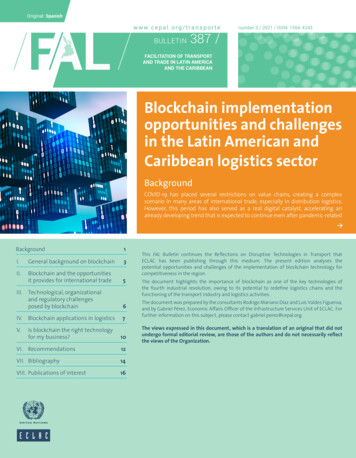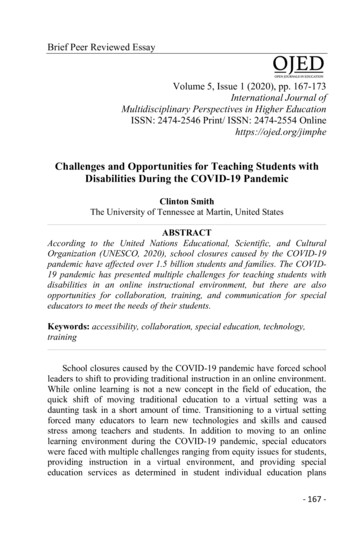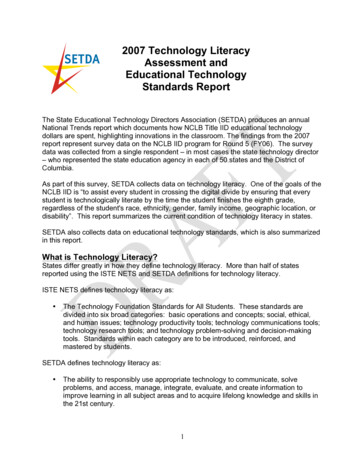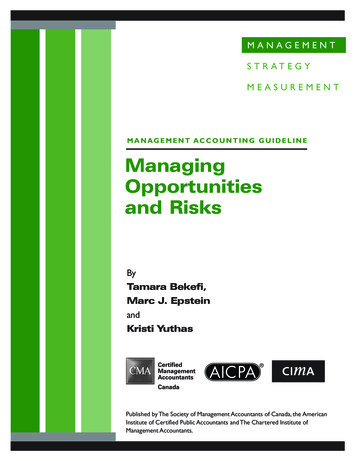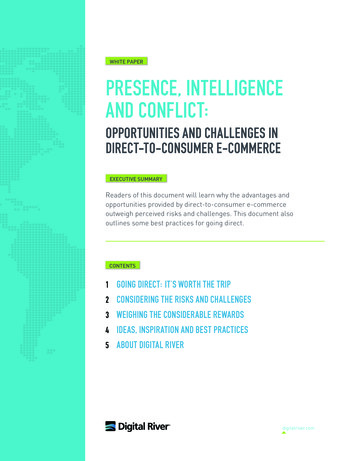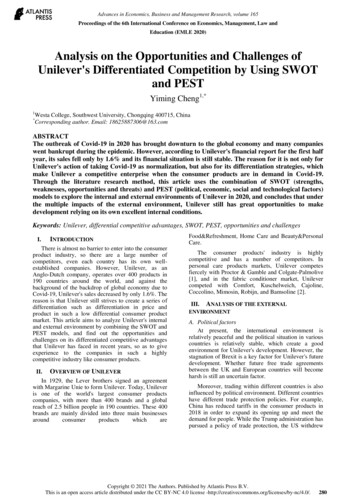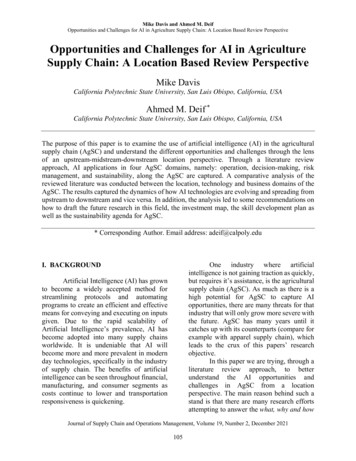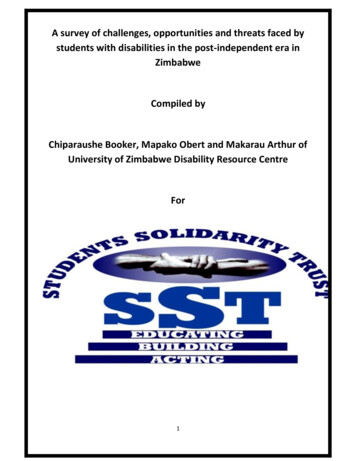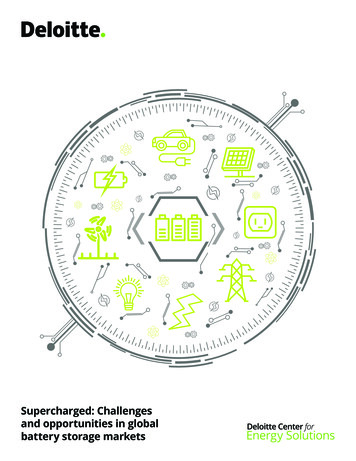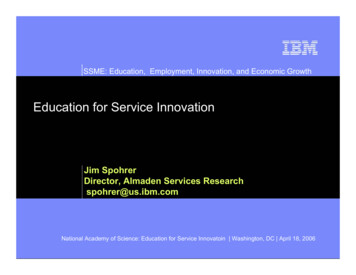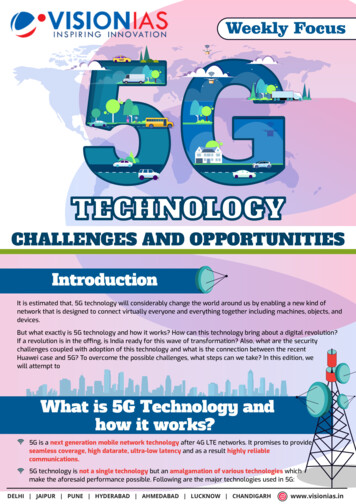
Transcription
Weekly FocusTECHNOLOGYCHALLENGES AND OPPORTUNITIESIntroductionIt is estimated that, 5G technology will considerably change the world around us by enabling a new kind ofnetwork that is designed to connect virtually everyone and everything together including machines, objects, anddevices.But what exactly is 5G technology and how it works? How can this technology bring about a digital revolution?If a revolution is in the offing, is India ready for this wave of transformation? Also, what are the securitychallenges coupled with adoption of this technology and what is the connection between the recentHuawei case and 5G? To overcome the possible challenges, what steps can we take? In this edition, wewill attempt toWhat is 5G Technology andhow it works?5G is a next generation mobile network technology after 4G LTE networks. It promises to provideseamless coverage, high datarate, ultra-low latency and as a result highly reliablecommunications.5G technology is not a single technology but an amalgamation of various technologies whichmake the aforesaid performance possible. Following are the major technologies used in 5G:DELHI JAIPUR PUNE HYDERABAD AHMEDABAD LUCKNOW CHANDIGARHwww.visionias.in
8468022022www.visionias.inmmWave (millimetre Wave): 5G technology envisages to use frequencies up to 100GHz which come inthe range millimetre frequencies (30GHz to 300GHz). In contrast, 4G technology operates in 1GHz to6GHz band. The advantage of mmWave band is that it is less used and also higher frequency wavecarries much more data than lower frequency wave.5G New Radio (NR) is the global standard for aunified, more capable 5G wireless air interface.5G NR uses two frequency ranges: sub-6 GHzfrequency bands and frequency bands in themmWave range (24-100GHz).Massive multi-user MIMO (Multiple input multipleoutput): This enables the network to have moreantennas per unit (signal towers), thus ensuringlarger and faster transmission of data.Small Cell stations: The mmWave technology ismore susceptible to obstacles and tend to loseenergy more quickly, therefore providing lesscoverage in comparison to their low frequencycounterparts. To overcome this, small cell stationsare needed to connect the base stations and usersseamlessly. Small cells make use of low-power,short-range wireless transmission systems (or“base stations”) that cover small geographicalareas or small proximity indoor and outdoorspaces.Beamforming: It can be visualized as a laser beambetween transmitting entity and the user. Thistechnology makes transmission of data more directional resulting in reduced interference andincreased energy efficiency in transmission.NOMA (Non-Orthogonal Multiple Access): Thistechnology allows multiple signals to use the samefrequency channel thus improving load capacity ofevery channel.Mobile Edge Computing (MEC): MEC brings cloudcomputing closer to the user physically. This hastwin advantages- One, reduced distance decreasesthe latency period and second, by keeping just therequired data near the user, it is also reduces theamount of data that the server has to handle, whichalso speeds things up.Related definitionsand concepts:Bandwidth commonly measured in bits/secondis the maximum rate at which information canbe transferred.Throughput is the actual measure of howmuch information is successfully transferred.Latency is the delay between the sender andthe receiver decoding the information. This ismainly a function of the signals travel time, andprocessing time at any nodes the informationtraverses.Test bed is a platform for conducting rigorous,transparent, and replicable testing of scientifictheories, computational tools, and new technologies.Network virtualization: Network virtualizationis the process of consolidating hardware andsoftware resources into a software-based,virtual network.Edge computing is a distributed computingparadigm that brings computation and datastorage towards the edge of the network i.e.closer to the location where it is needed byusing “cloudlets”, It thus provide contentcaching, service delivery, storage andIoT management resulting inbetter response times and transfer rates.Apart from above, there are several technologies which could become part of the 5G network. The finalstandard for 5G technology will be set up by the International Telecommunications Union (ITU).DELHI JAIPUR PUNE HYDERABAD AHMEDABAD LUCKNOW CHANDIGARHwww.visionias.in
8468022022www.visionias.inHow can 5G Technology potentiallybring about a digital revolution?A recent 5G Economy study has estimated that by the year 2035, 5G technologywill generate 13.2 Trillion dollars of global economic output by supporting awide range of industries. It also estimated that 5G value chain (including OriginalEquipment Manufacturer(OEMs), operators, content creators, app developers, andconsumers) could alone support up to 22.3 million jobs globally.But how exactly will this revolution be materialized andwho will be the major beneficiaries? All the majorapplications and services supported by 5G can be broadly divided in three use cases (A use case is a softwareand system engineering term that describes how a useruses a system to accomplish a particular goal):enhanced Mobile-Broadband- Peak speed 20 Gbps- Edge area 100 MbpsHigh speed use cases (a.k.a. Enhanced MobileBroadband (eMBB)): By transmitting data fasterUltra Reliable& Low Latencyand ensuring more uniform data rates, 5G will help- 1ms Latencyspeed up a range of applications such as enhanced- 10 Error-rate, Ultra reliabilityconsumer experience via high quality streaming,faster storage and access of cloud by businesses,better communication between public institutions and citizens.8K5G-9massive MachineType Communications- 1 million device connections/km2- High energy efficiencyMission-critical communication use cases (a.k.a. Ultra-Reliable and Low Latency Communications (uRLLC)):This will provide seamless communication between entities making possible real time interactions. Here,we will see new applications that require response in fractions of a second such as Autonomous Vehicles,Augmented Reality (AR) and Virtual Reality (VR), enhanced range and interactivity of drones.Massive Internet of Things (IoT) (a.k.a. Massive Machine-Type Connectivity (mMTC)): 5G is meant to seamlessly connect a massive number of embedded sensors in virtually everything through the ability to scaledown in data rates, power, and mobility—providing extremely lean and low-cost connectivity solutions. It iseasily showcased in areas like Smart City Infrastructure and Traffic Management, Industrial Automation,Wearables and Mobile devices, Precision agriculture etc.Is India ready for thiswave of digitaltransformation?According to some estimates, 208 million new subscribers will get connected in India by the year 2025. Also,it is estimated that increasing 5G subscribers could create a cumulative economic impact of 1 trillion in Indiaby 2035. Moreover, the technology will unleash new business opportunities and bring substantial socioeconomic benefits through increase in productivity, improvements in service delivery, optimum use of scarceresources as well as creation of new jobs.But to realize this potential transformation, several hurdles have to be crossed, ranging from technological,financial, infrastructural and most importantly the security concerns that have arisen.DELHI JAIPUR PUNE HYDERABAD AHMEDABAD LUCKNOW CHANDIGARHwww.visionias.in
8468022022Technological Challenges:Availability of spectrum: 5G needs a significantamount of new harmonised mobile spectrumwithin three key frequency ranges to deliverwidespread coverage and support all use cases:sub-1 GHz, 1-6 GHz and above 6 GHz. This may bedifficult due to unavailability of some bands. Forexample, DoT has acceptedISRO’s demand to reserve26 GHz band primarilyfor satellite serviceswhich will make deploymentof 5G challenging.Electronic EquipmentManufacturing: Importsaccount for about 90%of India’s telecom equipmentmarket resulting in highimport dependency on the complete 5Gsupply chain.Testing Challenges: 5G technology will need to takeon the characterizing and testing of new systems toensure both performance and regulatory adherence.www.visionias.inGrowth of Wireless Networks in IndiaThe first mobile phone service was launched in1985 on a non- commercial basis, but it was onlyin 1995 that commercial service was started.Beginning 2007, the subscriber base rapidlyincreased reaching 560 million in 2009 andwell over a billion by 2017.Early deployment of mobile networks wasbased on 2G technology, with 3G technologyentering service in 2010 and 4G in 2016.All mobile services from 2G to 4G offeredservices based on increasingly advancedphones, with smart phones arriving about adecade ago.3G5G1G1,9 Kbits/sPhone Calls2G50 Gbits/s4G Feature High-LevelinternetConnection10 Kbits/sSMS,Internet14.7 Mbits/sPictures,Video4G60 Mbits/s Music,Video CallsStreamingmmWave and beamforming technologies present the biggest testing challenges as they have tobe tested simultaneously with other technologies.Financial Challenges:Capital Investment: It is anticipated that industry might require an additional investment of 60- 70billion to seamlessly implement 5G networks. In midst of rising debt levels and market consolidationactivity, the telcos are seen to be constrained on capital expenditure.The Average Revenue Per User (ARPU) for telecom service providers has drastically reduced. Theindustry had a cumulative debt of Rs. 7.7 trillion in 2018.High Tax burden: Close to 30% of revenue of Telcos goes to the Government in taxes and levies, whichincludes Import duty for equipment such as base stations, optical transport gear etc.Infrastructural Challenges:Backhaul Infrastructure: India lacks a strong backhaul to transition to 5G. Nearly 75% of cell sites areconnected through microwave backhaul, while under 25% sites are connected through fibre. Theformer has bandwidth issues as it uses traditional bands while the latter provides low latency andunlimited capacity (a prerequisite for 5G).The term backhaul is often used in telecommunications and refers to a high capacity line transmitting a signal from a remote site or network to another site, usually a central one. The high throughput offered by 5G will result in high traffic on cellular networks which will need to be backhauledfrom mobile sites to an operator’s core network (Central Exchange).Increasing role of memory and storage infrastructure: With 5G, the quantum of data generated fromusers’ devices multiplies, resulting in more data that has to be stored, moved, processed and secured.This brings need for large scale enhancement in memory and storage infrastructure.DELHI JAIPUR PUNE HYDERABAD AHMEDABAD LUCKNOW CHANDIGARHwww.visionias.in
8468022022www.visionias.inRight of Way (RoW) and Lack of uniform policy framework: Delays due to complex procedures acrossstates and non-uniformity of levies along with administrative approvals impact telecom service providersin rolling-out Optical Fibre Cables (OFC) and telecom towers necessary for 5G.Other challenges:Privacy concerns: From the user’s perspective, privacy concerns centre around location tracking, identity, and other personal data. For instance, since 5G uses more antennas with smaller coverage area, itallows for precise location tracking of users both inside and outside.Digital Divide: In the current context, 5G is feasible mainly for more populated areas, where manyantennas can be placed close together. This brings challenge of widening of the digital divide, rural areaswhere user density would be relatively low and regions with poor digital infrastructure would be left out.How adoption of 5G Technology could generatea cyber security challenge?Wireless communication systems have always been prone to some security vulnerabilities. In the early 1980s,1G networks saw mobile phones being targeted for illegal cloning and masquerading. On early 2G networks,message spamming was commonplace. With 3G and 4G networks, proliferation of smart devices moved thethreats faced by computer systems to wireless domain.5G wireless networks will connect over 7 trillion wireless devices serving over 7 billion people, ushering a newera of security threats, which could arise in following forms:Decentralized security needs: Pre-5G networks had fewer hardware traffic points-of-contact, which made iteasier to do security checks and upkeep. 5G’s dynamic software-based systems have far more trafficrouting points. To be completely secure, all of these need to be monitored. Since this might prove difficult,any unsecured areas might compromise other parts of networkCritical infrastructure protection: 5G will enable real-time connectivity within critical infrastructure. Thus,any possible weakness in the network security can threaten security of this infrastructure and in turn maythreaten our national security. For instance, recent cyber-attacks on Kudankulam Nuclear Power Project aswell as on ISRO showcase our cyber vulnerabilities.Many IoT devices are manufactured with a lack of security: As more devices are encouraged to connect,billions of devices with varied security means billions of possible breach points thus increasing overallvulnerability of the system.Network Switching: Another security risk is posed by the protocol designed to allow 4G or 3G connectionswhen a dependable 5G signal isn’t available. When a 5G device switches to 3G or 4G, it is exposed to thevulnerabilities that haven’t been addressed in the previous generations’ protocol.More bandwidth will strain current security monitoring: While current networks are limited in speed andcapacity, this has actually helped providers monitor security in real-time. So, the benefits of an expanded5G network might actually hurt cyber security.DELHI JAIPUR PUNE HYDERABAD AHMEDABAD LUCKNOW CHANDIGARHwww.visionias.in
8468022022www.visionias.inHuawei Case: 5G Technology andGlobal GeopoliticsRecently, US formally designated Huawei Technologies Company and ZTE Corporation, leading companies in 5G technology research, as “national security threats”.(Huawei Technologies is a Chinese multinational company which designs,develops, and sells telecommunications equipment and consumerelectronics such as Cables (OFC) and telecom towers necessary for 5G.)There is an apprehension that Huawei Technologies may provide an innersystem to enable surveillance and cyber-espionage for China. Thisapprehension is due to following reasons:Both Huawei and ZTE have close ties to the Chinese Communist Party andChina’s military apparatus, and both companies are broadly subject to Chineselaw obligating them to cooperate with the country’s intelligence services.They have been accused of spying for Chinese Government by sharing data of foreigncitizens.The distrust has further multiplied because of China's policy to control and dominatevarious sectors through its software and hardware systems.As a result, many countries have become sceptical of them. For instance, France may deteroperators from using the Chinese telecom giant’s equipment. Also, UK has rejected Huaweias a 5G partner, and said that it is now forging an alliance of ten democracies (D-10) tocreate alternative suppliers for 5G and other technologies from China. (The 'D10' club ofdemocratic partners, includes G7 countries – UK, US, Italy, Germany, France, Japan andCanada – plus Australia, South Korea and India.)In response to this allegation, Huawei has criticized the decision of these governmentsas political and based on “ideological prejudices,” rather than actual security concerns.Also, to counter a D-10 like geopolitical exclusion, China has made a proposal tocreate a ‘BRICS innovation base’ to take forward 5G and Artificial Intelligence (AI)cooperation among the five countries.Since, there is no hard evidence against Huawei currently, the issue is being linked tothe ongoing trade war between US & China and has thus sparked a debate betweenfree commerce and national security. Taking another geoeconomics turn, the issue hasthe potential to set off a technological arms race between US and China.India’s Position in the debateThe Confederation of All India Traders (CAIT) has asked to ban Chinese companies Huawei and ZTE fromparticipating in 5G network roll-out in the country. It also urged that technology and equipment of bothcompanies should be banned from use in 5G network rollout by any company.Apart from CAIT, other industry bodies such as the Telecom Equipment Manufacturers Association ofIndia (TEMA) have also urged the Centre to use products made in India to provide telecom connectivity,especially to border and sensitive areas in the country.In the context of strained India-China ties, government has been citing security and strategy related issuesand thus indicating towards exclusion of these firms from the 5G roll-out in India.DELHI JAIPUR PUNE HYDERABAD AHMEDABAD LUCKNOW CHANDIGARHwww.visionias.in
8468022022www.visionias.inSteps already taken by Governmentto kick-start 5GA 5G High Level Forum was set up by the Government in 2017 to articulate the Vision for 5G in India and torecommend policy initiatives and action plans to realize this vision.It aims to achieve a globally-competitive product development and manufacturing ecosystem targeting50% of India’s market and 10% of global market over 5-7 years.The forum has kept aside a corpus of Rs. 500 crore for R&D in 5G technology.Cellular Operators Association of India (COAI) has formed the 5G India Forum (5GIF) that is expected toserve as a national initiative where all stakeholders, private and public, small and large, can meet anddiscuss the challenges of making 5G a reality in India, in conjunction with leaders of the rest of the world.To improve testing capabilities:The Government has launched a program titled ‘Building an End-to-End 5G Test Bed’. The programmeenvisages close collaboration between the universities and startups and create an ecosystem thatclosely resembles a real-world 5G deployment.The Department of Telecommunications (DoT) has simplified the testing method by making the spectrum available for demonstration purposes.The testing of 5G wireless products can now be done only through a self-declaration, stakeholderscan get the spectrum, and need not go through an elaborate approval process.Telecommunications Standards Development Society, India (TSDSI) hassuccessfully introduced an indigenously developed 5G candidate standardat the International Telecommunications Union (ITU) in 2019 for International Mobile Telecommunication (IMT)-2020 ratification.The National Digital Communication Policy-2018 (NDCP-2018) alsolays out the following objectives with respect to 5G services in India:Enabling Hi-speed internet, Internet of Things and M2M (Machine to machine) byrollout of several 5G technologies. Also, developing framework for accelerateddeployment of M2M services needs to be done while safeguarding security andinterception for M2M devices.Enhancing the backhaul capacity to support thedevelopment of next generation networks.Reviewing industry practices with respect to traffic prioritization to provide 5G enabled applications and services.DELHI JAIPUR PUNE HYDERABAD AHMEDABAD LUCKNOW CHANDIGARHwww.visionias.in
8468022022Way Forwardwww.visionias.in5G technology has the potential for ushering a major socio-economic transformation in India by enabling a rapid expansion of therole of information technology across manufacturing, educational,healthcare, agricultural, financial and social sectors. But from theaforementioned discussion it is clear that it is not without challenges. To embrace that potential and overcome these challengesfollowing steps could be taken:Technology and Infrastructure provisions:Core Technology and Manufacturing: Building India’s capacity in core technology development (Designand IP) and manufacturing for 5G and more broadly for all Information Technologies needs a deep andlong- term effort.Technology Demonstration and Major Trials: 5G trials will be an important learning opportunity for ourTelecom Service Providers (TSP), academia and industry. To enable this, major global Original EquipmentManufacturers could be invited to conduct major 5G trials in India in collaboration with local partners.Securing data center and cloud components becomes critical as mobile network components arevirtualized and potentially deployed on virtualized software infrastructure. To cover these unique software related risks, network providers will need to collaborate with cyber security firms to developsolutions for encryption, network monitoring, and more.Globally Harmonized Spectrum(GHS): A GHS would enable economies of scale and facilitate cross-border coordination and roaming for end users which is a critical factor for the initial deployment of 5G.Spectrum Harmonisation is a global effort under the auspices of the ITU to encourage governmentsand regulators to allocate RF spectrum consistently across borders, thereby enabling global roaming, interoperability and global markets for telecom equipment.Backhaul infrastructure can be strengthened by adopting higher capacity density: For 5G, the mobilenetworks would need to be densified using small cells. The compact size and low power (consumed andradiated) make small cells suitable for street level, lamp pole and indoor deployment.Privacy provisions:Creating a strong data protection policy and law to provide a legal framework which supports adoptionof 5G technology.Encapsulating a privacy-by-design approach that is service-oriented and privacy-preserving. It calls forprivacy to be taken into account throughout the whole engineering process.Data prioritization: Mobile operators need to adopt a hybrid cloud-based approach where sensitive datais stored locally and less sensitive data stored in the cloud.Using anonymity based techniques: Messages should also be encrypted before it is sent to a location-based service provider. Also, obfuscation techniques – where the quality of location information isreduced – can also be used to protect location privacy.Creating better authentication methodology: As IoT gains momentum, more people will be able toremotely operate or "talk" to networked devices. There is a need, therefore, for a more stringent authentication method, e.g. biometrics, to prevent unauthorised access.DELHI JAIPUR PUNE HYDERABAD AHMEDABAD LUCKNOW CHANDIGARHwww.visionias.in
8468022022www.visionias.inSecurity provisions:Providing End-to-end security solutions: 5G Security must address multiple end-to-end operations suchas IoT and devices, security operations, and network slicing security.Network slicing is the ability of the network to automatically configure and run multiple logicalnetworks as virtually independent business operations on a common physical infrastructure.Centralized reporting to build trust: This could be done by integrating 5G security systems with centralized reporting (integration) thus improving overall accountability of the system.National Cyber Security Strategy (NCSS) of India: Government is planning to rollout NCSS by upgradingNational Cyber Security Policy, 2013. The policy could incorporate the cybersecurity issues faced by 5Gtechnology, providing it a legal framework from security perspective.Increasing consumer education on IoT cyber security: User need to be taught various security protocolsto ensure safe usage. For example, the importance of securing all internet devices with softwareupdates, understanding the labelling standards for the IoT devices etc.Policy provisions:Spectrum Policy: 5G spectrum can be allocated in multiple phases based on readiness of the variousbands appropriately divided between wireless access, backhaul access and WiFI access.Participation in International Standards: Telecom networks need standards to ensure interoperabilityand to avoid market fragmentation. Getting active in global standards development eco-system willopen up a new realm of opportunities for India.Implementation and Oversight: A 5G Implementation Oversight Committee can be created with participation from Government, Academia, Industry and R&D Labs to supervise 5G program implementation.Education and Awareness Promotion Program like attracting global 5G conference events to India,setting up national 5G events and creating a comprehensive skills development program.The Department of Telecommunication (DoT) has sought a reduction in the goods and services tax(GST) on telecom gear and services.Conclusion5G technology presents India with an opportunity to becomea leader in one of the omnipresent technologies of the future.India must embrace this opportunity by deploying 5Gnetworks early, efficiently, and pervasively. Though there areseveral challenges from domestic deficiencies to geopoliticalquagmires. But, India has often leapfrogged the curve inadoption of the latest telecommunications technologies like4G in the past. Amid the rising connectivity demands duringCOVID-19, the time is ripe to make rapid strides towards 5Gdeployment.DELHI JAIPUR PUNE HYDERABAD AHMEDABAD LUCKNOW CHANDIGARHwww.visionias.in
8468022022www.visionias.inTOPIC AT A GLANCE5G Technology5G is a next generation mobile network technology after 4G LTE networks.5G technology is not a single technology but an amalgamation of various technologies.Major technologies used in 5G:mmWave (millimetre Wave): 5G technology envisages to use frequencies up to 100GHz.Massive multi-user MIMO (Multiple input multiple output) enabled network.Small cell stations to connect the base stations and users seamlessly.NOMA (Non-Orthogonal Multiple Access) allows multiple signals to use the same frequency channel.Mobile Edge Computing (MEC) brings cloud computing closer to the user physically.Potential use of 5G TechnologyEnhanced Mobile Broadband: High quality streaming, faster storage and access of cloud by businessesand better communication between public institutions and citizens.Mission-critical communication: Autonomous Vehicles, Augmented Reality (AR) and Virtual Reality (VR)and enhanced range and interactivity of drones.Massive Internet of Things (IoT): Smart City Infrastructure and Traffic Management, Industrial Automation, Wearables and Mobile devices and Precision agriculture.Challenges in achieving this potentialTechnologicalFinancialLack of spectrum availability.Domestic electronic ty of high capitalcost.High tax burden on Telcos.Testing challenges.Backhaul Infrastructure.Memory and storageinfrastructure.Lack of uniform policy framework.Cybersecurity challengesRequirement of decentralized security.Issue related to Network Switching.Real time critical information protection.IoT devices lack requisite security.Secure cloud computing.More bandwidth will strain current security.Way ForwardTechnology and infrastructure provisionsBuilding core technology and manufacturing capacity.Technology demonstration and major trials.Securing data centerand cloud components.Privacy provisionsCreating a strong dataprotection policy andlaw.Local storage ofsensitive data.Using anonymity-basedtechniques.Creating a GloballyHarmonized Spectrum.Using TemporaryMobile SubscriberIdentity (TMSI).Building Backhaul,memory and storageinfrastructure.Creating betterauthentication methodology.Security provisionsPolicy provisionsProviding end-to-endsecurity solutions.Adopting a clearspectrum policy.Adopting centralizedreporting to buildtrust.Participation indevelopments ofInternationalStandards.Implementation ofNational CyberSecurity strategy.Increasing consumereducation oncybersecurity andIoT.Creation of animplementationOversight Committee.Tax reduction for theTelecom Sector.DELHI JAIPUR PUNE HYDERABAD AHMEDABAD LUCKNOW CHANDIGARHwww.visionias.in
mmWave (millimetre Wave): 5G technology envisages to use frequencies up to 100GHz which come in the range millimetre frequencies (30GHz to 300GHz). In contrast, 4G technology operates in 1GHz to 6GHz band. The advantage of mmWave band is that it is less used and also higher frequency wave carries much more data than lower frequency wave. Massive multi-user MIMO (Multiple input multiple

